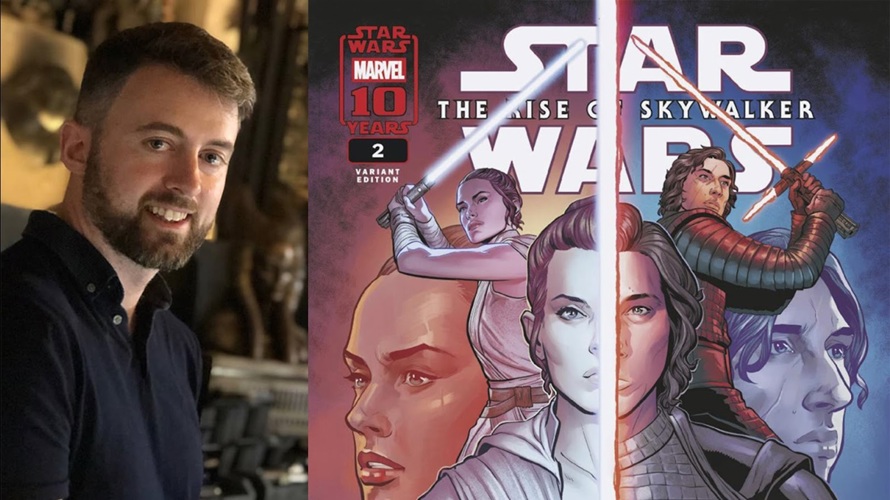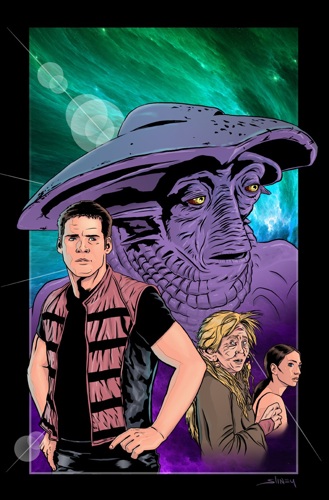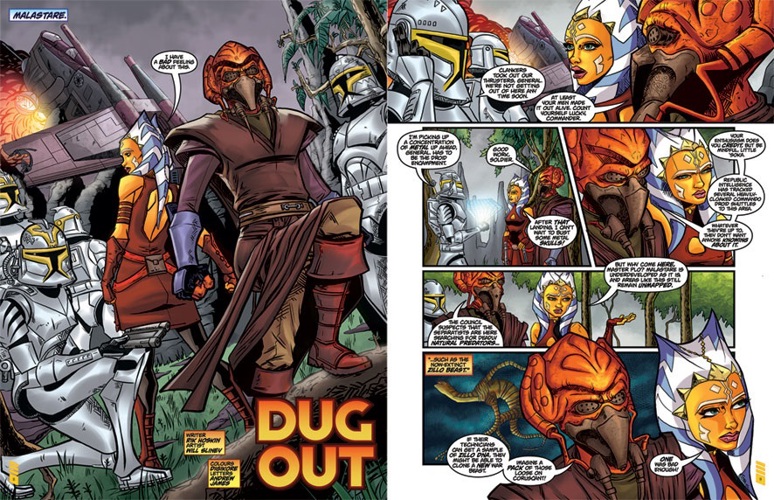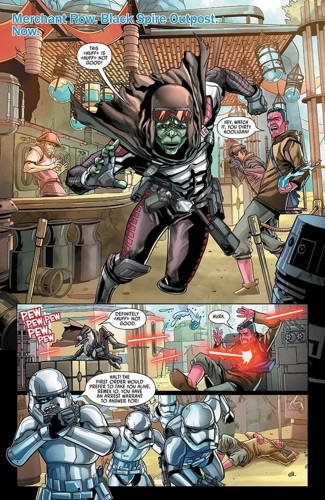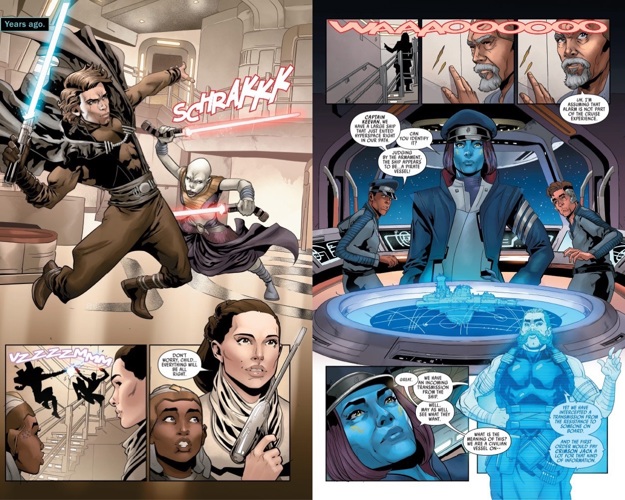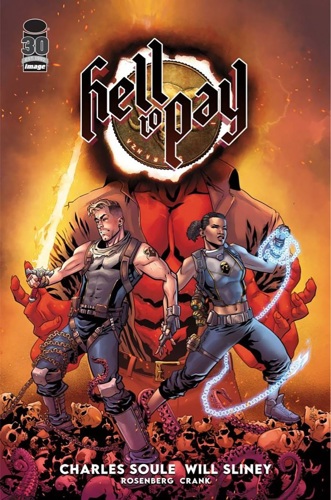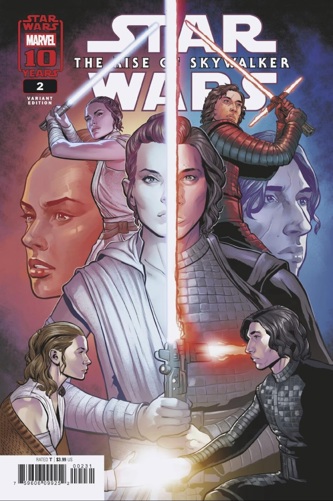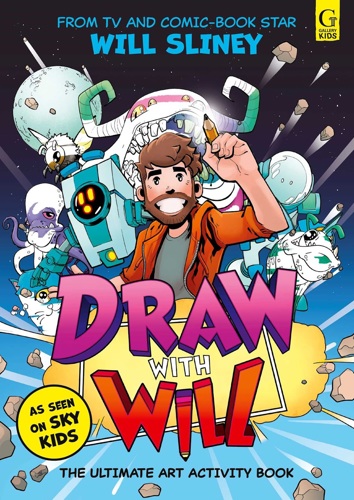Interview – Comic Book Artist Will Sliney Discusses Marvel’s Long-Delayed “Star Wars: The Rise of Skywalker” Adaptation
Acclaimed comic book artist Will Sliney (Celtic Warrior: The Legend of Cú Chulainn) has been working with Lucasfilm Publishing for nearly a decade and a half, and today his work on the Star Wars: The Rise of Skywalker adaptation has finally hit the shelves. In the interview below, I had the amazing chance to talk with Will about this project, his other Star Wars contributions, and his history as a fan and artist.
Mike Celestino, Laughing Place: What was your relationship with Star Wars growing up? I'm assuming you were a fan as a kid.
Will Sliney: Yes, you assume correctly, definitely. [laughs] I think Star Wars for me was the first thing that [made me] realize that there was more to stories than just a single film… and I mean that not just in terms of how the movies kind of carried on [with sequels], but that you could play and you could imagine and think about different stories that are set in those worlds. The strongest first memory I have of it was the way that you would rent a VHS video here– I'm from this tiny little fishing Village [on] the coast [of Ireland]. There's 400 people here, so we certainly didn't have a Blockbuster or an Xtra-vision, [which] was the name of our video rental place. It was 40 miles away, so a van would drive around with all of the videos for you to pick your one to rent once a week. And my mom would go up and she'd pick a video for us and come back, and we'd be all excited like, “What movie are we going to have this week?" And she came back with Star Wars.
And I just remember being upset with my mom, going, “I've already watched Star Wars," and I didn't realize it was a sequel. It was The Empire Strikes Back, so [that] was my first time realizing that there's this whole world [of stories], and that's been my relationship with it always– that you're allowed to tell and dream of these little stories. So I wouldn't just look at a toy; I would draw pictures of the toy and imagine where that Landspeeder could go and things like that. And certainly it was a big, strong factor in going down the kind of career route that I went.
LP: How did your career as a comic book artist actually get started?
Sliney: I certainly would have been trying to get to conventions whenever I could with my portfolio, going over to America– basically saving up or taking out loans to fly over, show my portfolio work around, and try and break into the companies. The first printed, published comic that I had then was with a local publisher here that also was a comic book store, so I drew that and then each comic that I drew led to another step up the ladder. So that led me to an English publisher for a book– I was doing that for a year and then I got picked up by Boom! Studios to work on Farscape, and did that for quite a while. I was very lucky to get picked up on a book that had this long run; I did 25 issues of Farscape and I got a ton of learning over that time– how to hit my deadlines, how to be consistent with the work, and how to work with likenesses and all that kind of stuff as well.
And then the whole time I was with them I was flirting with Marvel and showing my portfolio. My work was getting better and better until eventually it got to the point where they had a book for me. Very lucky again: it wasn't just a single book; it was like, “You're now the artist on Fearless Defenders and that's a full series." I ended up working with Peter David, who of course does these massive long runs, so we did like 60 issues [of Spider-Man 2099] together. So it kind of went from long run to long run, from one to the other very thankfully, so I was able to just focus on that and build and work in that world, and keep progressing my career.
LP: On Farscape, what was the process like of working on an existing, licensed property?
Sliney: A lot of research, obviously. I felt like I knew Ben Browder's face better than he probably did himself. Even with Star Wars you're always jumping around to different characters and telling stories from different perspectives, but Farscape is always him. So if I ever meet him I'll just be like, “I literally spent years drawing your face." And of course you're working with puppets that were designed by The Jim Henson Company, so like they all have brilliant designs, and it was nice being able to have all of this great stuff to draw from. These are well-designed characters and all the material you have to work with is brilliant. Star Wars is just that on a much bigger scale– you're standing on the shoulders of concept art giants and drawing their designs and making sure that everything looks as close to it as it possibly can.
LP: I believe your first Star Wars work was for The Clone Wars comic in 2011. Is that accurate?
Sliney: Yeah, and not a lot of people know that. It wouldn’t have been with Marvel; it was with an English publisher that [was] doing more kid[-friendly] things– a comic that would come with a toy and have puzzles and stuff like that as well. So it might have an eight-page strip in it, and I did a couple of them back then very much in the Clone Wars style. My style was quite different back then– it was more cartoony, so it [lent itself] to it more, and it was a huge dream come true to be a little part of that world. [I was] blaring the music as loud as I could, singing the theme song: “Can't believe this!" But it was eight pages, so it would have been over in a week or two. But it was cool, and it was just a little teaser, I guess, for what was ahead.
LP: As a Disney Parks fan I have to ask you about the work you did with Ethan Sacks for the Star Wars Galaxy's Edge miniseries and Galactic Starcruiser - Halcyon Legacy, because as the artist you were drawing these locations that were going to exist in real life before they were even accessible to anyone. So can you tell me about how you went about doing that? Were you provided with enough reference materials?
Sliney: That's actually the thing that I always say about it: I don't think any book artist has ever had to do that– draw a place that isn't real, [but] that will be real, which was crazy. Of course I was given reference, but things change when you're building things. They're literally physically building things [at Disneyland Resort and Walt Disney World], so I would get regular photos of how this place was shaping up, and I often talk about the corridors of the of the Starcruiser and how they were different from what I drew, because they just naturally changed as they were building them. And I was like, “Okay, I need to go back and redraw all of the corridors that we've done. That was just part and parcel. I loved it; it was just this amazing experience. I wasn't even provided with this, but there was this video online of [D23 Expo] when they revealed this scale model of Galaxy's Edge, and people were just walking around it, and I would look at every video I could possibly find of it. Then I built my own scale model of Batuu, so I could line up every camera angle whenever we would set something in there.
So I was there [at Star Wars: Galaxy’s Edge] the day it opened in Florida, and the first thing I saw when I walked into a park was a kid holding up the first page, literally finding that place where it was in the park to see how well it lined up. So that must happen all the time inside there, if I walked across it and that was the first thing I saw. So you're conscious and you want to get that right– you want them to feel like, “Whoa! This is really part of that world." [It was] obviously difficult when it didn't exist right, but fun.’
LP: So you’ve visited Galaxy's Edge, but did you have the chance to board the Halcyon?
Sliney: No. I was literally just talking about that with someone today, and I'm disgusted. I remember thinking at the time, “I'm going to wait. I'm going to bring my kids." I have young kids, so we're making our first Florida trip next year. They're now the right age for that. So obviously [I’m] pretty gutted that I didn't get to do it, even just down to seeing the things we got to draw in– like where a lightsaber hits the wall when Anakin battles Ventress, and then when you go there that mark is on the wall. You really would feel like you're a part of it. I never thought that I wouldn't get to do it, but the legacy of it is really living on– I'm hearing stories that there's a Halcy-Con convention.
LP: Let's talk about The Rise of Kylo Ren, another miniseries that I was a big fan of with writer Charles Soule. This would have been your first time drawing Ben Solo, I believe. Tell me a little bit about your first time diving into that character and what the experience was like in general working on that miniseries.
Sliney: That is my favorite project I've been a part of, for so many reasons. It felt so crucial to the Star Wars lore– it felt like we were really telling such an important story. And then you're given the gift of the keys to get to design so many different elements of it– obviously you can see that they're starting to show up in very interesting different ways [including the Ren helmet and lightsaber hilt available at Star Wars: Galaxy’s Edge]. We were working on that story as they were making The Rise of Skywalker, and this was as closely tied into all of that as it possibly could be, and we had to do it right. We were telling such an important part of that character’s story and it felt like a privilege. It was really cool to do it.
How many people get to literally design [their] own lightsaber? That's my lightsaber! [laughs] That is not something that happens that often. Ewan McGregor has a lightsaber, I feel like I have a lightsaber, so of course that's amazing. It's so strange to have that… so strange. And one of the most interesting things with it was turning it on and then realizing, “Oh, this is what it sounds like." It has its own unique sound that was designed by the Imagineers, but I never once thought about what this thing that you're drawing actually sounds like– just crazy– and it sounds really cool, so that's pretty amazing.
LP: Today marks the release, finally, of your Star Wars: The Rise of Skywalker adaptation. This was originally scheduled to come out in 2020, and we all know what was going on in the world in 2020. But can you tell me a little bit about what happened?
Sliney: Yeah, very simple: it just got paused and unpaused. Nothing in-between, except “Oh, I really hope this happens," because I've really taken a different approach with this book than definitely any Star Wars project, or anything I've done before, and I can't wait for people to see. We get to add in all this extra stuff to the lore [for one thing], but I've [also] tried to base all of the pages around the dyad and the reflection of the two characters, so a lot of panels are going to be laid out that way. There are certain Star Wars projects where you feel like you want to be as true and exact to what's [on screen], whereas this one it was really about, “I'm going to really delve into a visual way of showing this reflection balance that these two characters have.
You're going to see over the course of the five [issues] literally panel reflections and pose reflections and everything going out there in a way that you can only do in comics. There's literally layouts of panels that you can put a mirror up to them, and they will mirror each other in that way. I was really gutted that that wasn't going to get to come out. People are only going to start picking up on this as we go through the series and start to see all of these times when we got to do that, because obviously you can't do it for the whole story. I think like you've seen I have a cover for issue two that's out where you really can see the start of that– how everything is reflecting, so I can't wait for people to see it.
LP: You previously adapted Solo: A Star Wars Story in 2018 with writer Robbie Thompson. As an artist, can you compare and contrast the approach to adapting an existing story, as opposed to drawing a new original story for the Star Wars franchise?
Sliney: Even within that they're all different, because I've done a bunch of adaptations now, I've even done one that hasn't been announced yet. [Solo] was different in terms of, I didn't have an awful lot of access to what was out there in the world. I was trying to sneak in some fun stuff of putting Alden Ehrenreich into poses that would mirror Harrison Ford’s Han Solo– just little interesting things. I actually think I had a few throughlines between that and The Rise of Kylo Ren, of having Kylo pulling off those same finger points, so you get [to] do fun things like that. It depends on the project, genuinely. God, that one feels so long ago now it's hard to get in the headspace of what we got to do first. I've drawn a lot of Star Wars; I really have, and that was what I think about, because that was me moving from five years of Spider-Man over to Star Wars.
It’s now been longer– it has been six or coming up on seven years of Star Wars, and I literally started that project when I was like, “I have to have a little break, because my first son is about to be born." I'm about to ask Marvel for that break and then Star Wars came to them going, “Hey can we steal Will over to the Star Wars universe?" I'm like, “Uh oh. I can't ask for a break now." So it was a wild time, and we [had] just moved into a house that we built as well, so it was this real huge change in my life– going from Spider-Man in the house that we rented with no kids to Star Wars in the house that we built with kids. I guess that's probably why it's hard to put my headspace into thinking about what we were doing [when] we were drawing the comic then. I need to read that book again just to take a look.
LP: Can you talk about some of the writers that you've worked with on these Star Wars projects? What have your working relationships with some of these writers been like and how different are their approaches to the material?
Sliney: Yeah, absolutely well Ethan [Sacks] keeps popping back into my life with different projects, which is hilarious. The best experience I had with him would have been of course being a part of Galaxy’s Edge and going to Galaxy’s Edge together before the place opened and having the thing [to] ourselves. We would find each other and do the Millennium Falcon ride together and then run off like excited little kids. I was sitting in [Oga’s] Cantina by myself, with nobody else in there, just like, “I guess I'll just stay here and try another Fuzzy Tauntaun." And I had the Millennium Falcon to myself; it was crazy. And then it all built up to the next day– it was the preview day and [they had] this big celebration the first night that it opened. It was amazing. That trip to Galaxy’s Edge was probably the highlight of things that could happen from Star Wars for me.
Then what's lovely about Charles [Soule]-- Charles is one of my best friends in comics. We literally chat every day. We both knew each other before we broke into comics, which was nice, then we finally got to work together on The Rise of Kylo Ren, and we both enjoyed that working relationship so much that we got to bring out an Image series together with Hell to Pay. We literally just got to announce yesterday the solicitation for our next Image series together, which is called The Cold Witch. I loved working on that book; I loved the way we worked together [on Kylo Ren]– we’d just constantly be back and forth on WhatsApp designing stuff: designing what Snoke should look like, what the crazy [Amaxine Space Station] that Snoke is on should look like, what Ben Solo's outfit should look like. Ren obviously was a huge thing too– a huge character to design, and then we got to put a lot of thought into the lightsaber, not realizing that this thing was ever going to get made, or the helmet was ever going to get made. So it was awesome doing that book, and we continued to work together as well, which is cool.
Robbie [Thompson] has turned into a very good friend of mine. That was our only time we've worked together, I think. He's a video game pal– we get to play video games together. And Jody [Houser]... it's so weird, we got to work on this book for a month [in 2020], and we got to like chat loads, and it just got pulled. And both of us were like, “Oh no!" And any time we'd see each other it's like, “I hope that gets to happen again." So now it's nice that it happened, and today is obviously a big day of realization that this book is out there. It's mad. I'm delighted it's real.
LP: Was there anything else specifically unique or challenging for this particular project? And what excites you the most about this adaptation finally getting into the hands of readers?
Sliney: I don't know if I should say this… I think there's something that I got to draw in this that will be the Star Wars image that I will see shown back to be the most out of my entire career ever, and I can't wait for that to get out there. I was thrilled that we got to do it, and it's the beauty of comics. Sometimes in comics you tell stories in different ways– you can show different things, and obviously you can get inside characters’ minds with narration. That's why Peter Parker is such a unique comic book experience compared to when you're watching [him in] the movie. You're really in Peter Parker's mind. That's just a metaphor; it's not what we're doing in this, but… we should talk again in a few months’ time. [laughs] You’ll definitely know it when you see it.
LP: Lastly here you have a series and a tie-in book called Draw with Will. Can you tell me a little about that?
Sliney: So since the pandemic lockdown I basically randomly ended up being a presenter on the national broadcast. I was like their art teacher. I put out this tweet saying, “Any kid that’s stuck at home, here's my drawing of Spider-Man. Send me yours. I was expecting to get like 100 drawings and I got like 20,000 Spider-Man drawings. I was like, “Oh my God," because essentially the whole world was stuck at home. So the next day I did Star Wars and it went up to 50,000 drawings, and just every day I was getting sent so much. So this thing obviously went around the world, and every news article site like GQ, New York Times, BBC, everything, they'd be like, “If you want to do Fitness, follow this guy and do his YouTube thing he's doing every day. If your kids like art, follow Will Sliney and do his art stuff. So that led to me being picked up, literally making some stuff with this camera here for the national broadcaster. They did some content for kids at home– I became the art teacher [and] that went so well that they offered me my own TV series. And we ended up getting two: one with the broadcaster here, one with a broadcaster in the UK.
Here was Will Sliney’s Storytellers, which was a show about how to teach art but also tell stories, and the characters we drew came to life. And then Draw with Will is teaching people how to draw famous characters, so we'd have the likes of SpongeBob and Paw Patrol– loads of famous characters. And that just spinned out. Now at the end of the month is our first book. The show sells around the world; it's in loads of different languages. Hopefully it's coming to the US soon, and we got to do this book with Simon & Schuster uh which is coming out at the end of the month as well. So that's been really fun stuff to do– very different, but I love it. I love teaching kids how to draw, proving that every kid can do it. I really think that drawing is a skill and not a talent, and if you practice hard enough you can end up like me drawing Star Wars. If someone from a fishing Village in Ballycotton can do it, then anyone can.
Star Wars: The Rise of Skywalker #1 is available now wherever comic books are sold. Draw with Will will be released on Tuesday, March 27th and is available to pre-order right now.

